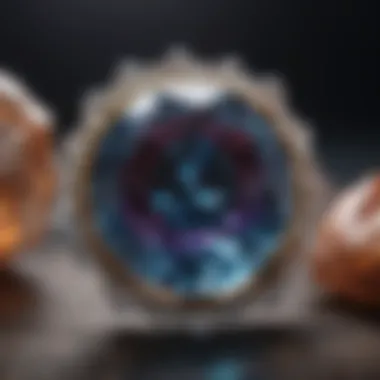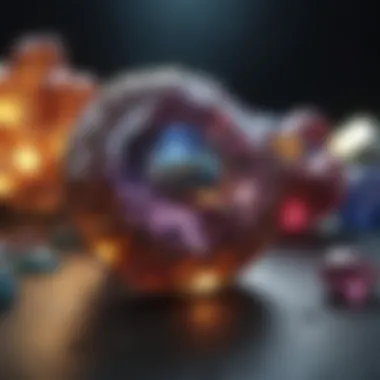Unveiling the Enigmatic Realm of Precious Gemstones: An Extensive Exploration


Overview of Gemstones and Minerals
Gemstones and minerals have captivated humans for centuries, their allure transcending mere physical beauty. The history of these geological treasures dates back to ancient civilizations, where they were revered for their rarity and mystical properties. Throughout history, gemstones and minerals have held significant cultural and societal importance, symbolizing power, status, and spirituality in various cultures globally.
Gemstone Formation and Properties
The formation process of gemstones is a complex and fascinating journey that spans millions of years. These precious stones crystallize deep within the Earth's crust under intense heat and pressure, resulting in their unique structures and compositions. Gemstones are characterized by a range of properties that set them apart, including color, hardness, luster, and clarity. These intrinsic features play a crucial role in determining the value and allure of each gemstone, making them highly sought after in the world of jewelry and collectibles.
Types of Gemstones
Gemstones are categorized into two main groups: precious and semi-precious stones. While precious gemstones like diamonds, rubies, sapphires, and emeralds command high value due to their rarity and exceptional beauty, semi-precious stones like amethyst, topaz, and quartz are more readily available. Beyond these classifications, there exists a vast array of common, exotic, and rare gemstones, each possessing its distinct appearance, properties, and cultural significance. The diversity of gemstone varieties offers a rich tapestry of colors and textures for enthusiasts and collectors to explore.
Identifying and Evaluating Gemstones
The value of a gemstone is determined by a multitude of factors, including its color, clarity, cut, and carat weight. Gemologists utilize various techniques and tools to identify and assess gemstones accurately, such as magnification, spectroscopy, and gemological testing. Understanding these evaluation methods is crucial for discerning the quality and authenticity of gemstones, ensuring transparency and trust in the gemstone market.
Caring for Gemstones
Proper care and maintenance are essential to preserving the beauty and longevity of gemstones. Regular cleaning and safe storage practices help prevent damage and dullness, prolonging the vibrancy of gemstones. Avoiding common mistakes, such as exposure to harsh chemicals or physical impact, is key to safeguarding delicate gemstone surfaces. Additionally, specific gem types may require specialized preservation techniques due to their composition and sensitivity, emphasizing the importance of tailored care routines for each precious stone.
Introduction to Precious Stones
Precious stones have fascinated humanity for centuries, serving not only as exquisite adornments but also as symbols of wealth, power, and culture. This section serves as the gateway to the mesmerizing world of gemstones, offering a profound understanding of their origins, properties, and significance. By exploring the geological processes responsible for shaping these treasures and unraveling their cultural and symbolic meanings, readers can embark on a journey that combines science, artistry, and history.
Defining Precious Stones
Characteristics of Precious Stones
The characteristics of precious stones play a pivotal role in determining their allure and value. From their mesmerizing colors and exceptional clarity to their durability and rarity, each gemstone possesses unique attributes that set it apart. Understanding the distinct characteristics of precious stones is crucial for gem enthusiasts and collectors alike, as it allows for a more informed appreciation of these natural wonders. The interplay of hue, tone, and saturation in gemstones reveals the intricacies of their beauty, making them a preferred choice for connoisseurs seeking elegance and sophistication.
Traditional Classification
Traditional classification systems categorize precious stones based on various criteria such as color, clarity, and brilliance. By adhering to these classifications, gemologists and jewelers can identify and assess gemstones with precision, unveiling their intrinsic qualities and market value. The historical context surrounding traditional classification provides valuable insights into the evolution of gemstone appreciation and trade, shedding light on the enduring legacy of these cherished treasures.
Historical Significance
Ancient Beliefs and Myths
Ancient civilizations revered precious stones for their mystical properties and believed in their ability to bestow protection, wisdom, and prosperity upon their wearers. Myths and legends from cultures around the world abound with references to gemstones, portraying them as objects of divine significance and celestial connection. Exploring the ancient beliefs and myths surrounding precious stones offers a glimpse into the spiritual realm of humanity's relationship with these alluring gems.
Role in Cultural Practices


Across various cultures and epochs, precious stones have held paramount importance in religious ceremonies, royal adornment, and societal rituals. Their symbolic significance transcends mere aesthetics, serving as conduits of spiritual energy, social status, and heritage. Understanding the significance of precious stones in cultural practices provides a holistic view of their role in shaping human interactions, traditions, and beliefs, enriching the tapestry of our shared history.
Formation Process
Geological Conditions
The formation of precious stones is a testament to the intricate interplay of geological forces over millions of years. Specific geological conditions such as extreme pressure, temperature, and mineral compositions contribute to the crystalline structure and coloration of gemstones. Delving into the geological conditions that give rise to these exquisite gems unveils the fascinating natural processes that transform humble minerals into objects of extraordinary beauty.
Crystal Growth
The growth of crystals within the earth's crust is a mesmerizing phenomenon that yields the diverse array of precious stones seen today. From the gradual accretion of mineral molecules to the intricate lattice structures that define their shape, crystal growth imbues gemstones with their unique properties and optical brilliance. Exploring the intricacies of crystal growth enhances our appreciation for the precision and artistry of nature's craftsmanship in creating these mesmerizing treasures.
Popular Types of Precious Stones
Exploring popular types of precious stones is a pivotal aspect of this comprehensive guide to the world of precious stones. Understanding the significance and characteristics of different types of gemstones such as diamonds, rubies, sapphires, and emeralds provides valuable insight into the diverse and exquisite world of gemstones. Each type of precious stone offers unique qualities, colors, and cultural significances that make them highly sought after in various industries, from jewelry design to healing practices.
Diamonds
Structure and Composition
In the realm of precious stones, diamonds stand out for their exceptional structure and composition. The crystalline structure of diamonds, formed under immense pressure and heat deep within the Earth's mantle, gives them unparalleled strength and brilliance. Composed of carbon atoms arranged in a tight, symmetrical pattern, diamonds exhibit excellent durability and refractive properties. This unique structure allows diamonds to refract light in a captivating manner, creating the renowned dazzling sparkle that makes them a popular choice for high-end jewelry pieces.
Famous Diamonds
When delving into the world of famous diamonds, one encounters stories of unparalleled beauty and history. Each famous diamond, whether it be the Hope Diamond or the Koh-i-Noor, carries with it a legacy of wealth, intrigue, and prestige. These diamonds, known for their exceptional size, color, and clarity, have captured the imagination of generations, becoming symbols of luxury and opulence. The fame attached to these diamonds elevates their value and desirability, making them prized possessions sought after by collectors and connoisseurs worldwide.
Rubies
Color Varieties
Exploring the rich color varieties of rubies unveils a mesmerizing spectrum of red hues ranging from deep crimson to bright pink. The vibrant color of rubies comes from trace elements such as chromium within the corundum mineral structure. Different sources of rubies yield distinct shades, each with its unique allure and symbolism. The captivating red glow of rubies symbolizes passion, vitality, and courage, making them popular choices for expressing deep emotions and making bold fashion statements.
Significance in Different Cultures
The significance of rubies in different cultures spans centuries, with these gemstones holding deep cultural and symbolic meanings. In ancient civilizations and modern societies alike, rubies have been revered as symbols of power, protection, and love. Their association with royalty and nobility reflects the value placed on rubies as tokens of power and authority. Whether worn as jewelry or used for ceremonial purposes, rubies continue to captivate hearts and minds, embodying timeless beauty and significance.
Sapphires
Blue Sapphires vs. Fancy Sapphires
Distinguishing between blue sapphires and fancy sapphires showcases the diverse range of colors and varieties within the sapphire family. While blue sapphires are revered for their deep blue hues, fancy sapphires encompass a broader spectrum of colors, including pink, yellow, and green. Each type of sapphire offers a distinct appearance and character, appealing to different tastes and preferences. Blue sapphires exude elegance and sophistication, while fancy sapphires allow for creative and unique jewelry designs that cater to individual style statements.


Mythological References
The mythological references surrounding sapphires add an element of mystique and intrigue to these enchanting gemstones. From ancient legends depicting sapphires as celestial gifts to mythological tales linking sapphires to divine protection and wisdom, these gemstones have been woven into the fabric of numerous cultures. Sapphires are often associated with spirituality, truth, and enlightenment, making them prized possessions believed to bring inner peace and clarity to those who wear them.
Emeralds
Characteristics and Quality Factors
Exploring the characteristics and quality factors of emeralds sheds light on their distinctive allure and value in the gemstone world. Emeralds are prized for their vivid green color, often imbued with a calming and regal essence. The inclusion of vanadium and chromium in emeralds' chemical composition produces their signature green hue, with varying intensities and tones dictating their quality and price. Inclusions, known as jardin, are intrinsic to emeralds and can impact their overall appearance and value, with high-quality emeralds exhibiting minimal inclusions and exceptional transparency.
Legendary Emeralds
Legendary emeralds carry tales of grandeur and legacy, adding layers of intrigue and fascination to these revered gemstones. From the famed Chalk Emerald to the Patricia Emerald, each legendary emerald boasts a unique history and provenance that elevates its value and allure. These emeralds have graced the crowns of royalty, adorned the jewelry of luminaries, and captured the imagination of gemstone enthusiasts worldwide. Their legendary status ensures that they remain timeless symbols of luxury and sophistication.
Properties and Quality Assessment
In the realm of precious stones, understanding the Properties and Quality Assessment is paramount. These aspects serve as the cornerstone for evaluating the value and allure of gemstones. Properties encompass various factors like color, clarity, cut, and carat weight that collectively determine a gem's quality and market worth. Quality Assessment involves meticulously scrutinizing each gemstone to assess its purity, brilliance, and rarity. Through this detailed examination, gem experts can differentiate between average stones and fine specimens, guiding buyers and collectors towards optimal choices.
Color
Role of Hue, Tone, and Saturation
When it comes to gemstones, the Role of Hue, Tone, and Saturation plays a vital role in their overall appeal. Hue refers to the dominant color of the stone, be it red, blue, green, etc. Tone deals with the depth of color, while Saturation measures the intensity or vividness of the hue. The interplay of these elements determines the visual impact and beauty of a gemstone, making it a crucial consideration for discerning buyers and gem enthusiasts. Understanding how these factors influence a gem's color can help individuals appreciate its rarity and aesthetic charm.
Color Grading Standards
Color Grading Standards are essential guidelines used to evaluate a gemstone's color quality. These standards establish a uniform language for describing and comparing gem hues, ensuring consistency and accuracy in gemstone assessments. By adhering to recognized color grading scales, such as those employed by reputable gemological institutions, individuals can effectively communicate and comprehend the subtle distinctions in color variations. This standardized approach aids in gauging the desirability and value of different gemstones, assisting consumers in making informed decisions based on color preferences and market trends.
Clarity and Inclusions
Impact on Value
Clarity and Inclusions significantly impact a gemstone's value and visual appeal. The presence of inclusions, or internal imperfections, affects a gem's transparency and brilliance. Gemological experts carefully assess these characteristics to determine a stone's clarity grade, ranging from flawless to included. The rarity of flawless gems commands higher prices due to their exceptional purity and luminosity, making clarity a crucial factor in gem valuation and selection.
Common Types of Inclusions
Exploring the Common Types of Inclusions enables gem enthusiasts to identify and appreciate the natural formations found within gemstones. These inclusions, such as crystals, feathers, or needles, not only provide insights into a gem's geological history but also add to its unique character and charm. While some inclusions enhance a gem's beauty, others may impact its durability or clarity. Understanding the common types of inclusions empowers individuals to make informed choices when acquiring gemstones, taking into account both aesthetic preferences and practical considerations.
Cut and Shape
Ideal Proportions


The Ideal Proportions of a gemstone's Cut significantly influence its brilliance, fire, and overall visual appeal. Gem cutters meticulously shape and polish gemstones according to precise proportions and angles to maximize light reflection and dispersion. Well-proportioned cuts enhance a gem's luster and sparkle, showcasing its inherent beauty and quality. By evaluating a gem's cut craftsmanship and adherence to ideal proportions, buyers can appreciate the artistry and skill involved in enhancing a gemstone's inherent radiance.
Faceting Styles
Exploring the world of Faceting Styles reveals the artistic diversity and creativity employed in shaping gemstones. Various faceting techniques, such as brilliant, step, or mixed cuts, impart distinct patterns and effects to gem surfaces, amplifying their visual allure and character. Each faceting style reflects a unique aesthetic sensibility and design philosophy, adding depth and sophistication to a gemstone's overall appearance. Understanding the nuances of different faceting styles enables individuals to recognize and select gemstones that resonate with their personal tastes and style preferences.
Carat Weight
Measurement and Pricing
The measurement and Pricing of a gemstone are intricately linked to its Carat Weight, a key determinant of value and rarity. Carat weight refers to the mass of a gemstone, with one carat equivalent to 200 milligrams. Pricing is often influenced by carat weight, with larger stones generally commanding higher prices due to their scarcity and visual impact. Understanding how carat weight affects gemstone pricing enables buyers to make informed decisions based on budget considerations and desired gem size.
Significance of Carat
The Significance of Carat extends beyond weight measurement to symbolize prestige and luxury in the world of gemstones. Carat size is a visible indicator of a gem's grandeur and rarity, influencing its perceived value and status. While carat weight is a crucial factor in gem pricing, other quality aspects like color, clarity, and cut also play pivotal roles in determining a gem's overall worth. By grasping the significance of carat weight in gem evaluation, collectors and enthusiasts can appreciate the intrinsic value and allure of varying carat-sized gemstones.
Cultural and Symbolic Meanings
The section of Cultural and Symbolic Meanings within the comprehensive guide on Exploring the World of Precious Stones delves deeply into the intrinsic value that these gems hold beyond their physical properties. It unravels the historical, astrological, and emotional significance attached to various precious stones, providing a profound insight into how these gems have influenced cultures and symbolized values over centuries. Understanding the cultural and symbolic meanings of gemstones adds a layer of richness to their allure for enthusiasts and collectors alike.
Astrological Connections
Birthstones and Zodiac Gems
Exploring the Birthstones and Zodiac Gems is a pivotal aspect of this article, shedding light on the profound connections between celestial bodies and gemstones. Birthstones and Zodiac Gems hold a special place in the hearts of many, believed to carry unique energies and influences based on one's birth month or zodiac sign. The significance of these gems in astrology and personal well-being underscores their timeless appeal and relevance in today's world. Their representations of individuality and guidance in personal choices make them a popular choice for those seeking meaningful connections to the cosmos.
Influence on Personalities
Analyzing the Influence on Personalities in relation to precious stones offers a compelling narrative on how gemstones are believed to reflect and affect one's character traits. The idea that certain gems resonate with specific personalities or characteristics has fascinated individuals for ages. Exploring how gemstones can enhance or balance personality traits adds a spiritual dimension to the appreciation of these precious stones. Recognizing the impact gemstone choices can have on individuals' self-expression and sense of identity enriches the exploration of gemstone lore and practices.
Historical Significance
Royal Treasures
Unveiling the Royal Treasures associated with precious stones uncovers a world of opulence, power, and prestige that has characterized monarchies and dynasties throughout history. These exquisite gems, often adorning crowns, scepters, and regal attire, symbolize authority and divine favor. Studying the significance of gemstones in royal settings offers a glimpse into the grandeur and splendor of bygone eras, where gemstones were emblematic of wealth and status. Their presence in regal collections highlights the enduring allure of gemstones beyond mere adornment.
Religious Symbolism
Exploring the Religious Symbolism surrounding precious stones reveals the spiritual and metaphysical dimensions attributed to these gems across diverse cultures and faiths. From talismans to relics, gemstones have served as conduits for divine energy and protection in religious practices worldwide. Understanding the symbolic meanings attached to specific gemstones adds depth to religious ceremonies and rites, fostering a deep connection between believers and the sacred. The symbolic role of gemstones in religious traditions reflects their enduring significance in promoting faith and spiritual well-being.
Modern Interpretations
Contemporary Jewelry Trends
Delving into Contemporary Jewelry Trends brings forth the innovative and evolving ways in which gemstones are incorporated into modern designs. From minimalist aesthetics to bold statements, contemporary jewelry showcases the versatility and timelessness of gemstones in fashion. The fusion of traditional craftsmanship with avant-garde concepts reflects the dynamic nature of jewelry trends that appeal to diverse audiences. Exploring the ever-changing landscape of contemporary jewelry offers a glimpse into the creative intersections between gemstones, design, and personal expression.
Symbolism in Fashion
The exploration of Symbolism in Fashion uncovers the sartorial significance of gemstones in the world of style and glamour. Gem-embellished fashion pieces convey meanings beyond aesthetics, serving as visual representations of emotions, beliefs, and cultural motifs. Understanding how gemstones symbolize themes of love, strength, or heritage in fashion elucidates the multifaceted nature of these precious stones. From red carpet showcases to everyday wear, gemstone symbolism in fashion transcends trends, weaving narratives of beauty and significance into the fabric of modern style.







